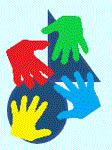
|
Washington State Math Olympiad
Hints and Solutions
2008 Grade 8 Probability and Statistics
|
 |
| Problem |
Solution |
1) There are two coins in a bag, one that has heads on both sides and one that is weighted so that heads comes up twice as often as tails. What are the odds of randomly selecting a coin out of the bag, flipping it, and having it land on tails?
|
- The probability of getting the coin that has a tails is 1⁄2
- If you get the coin that has a tails, then the probability that you will get the tails is 1⁄3
- The combined probability is 1⁄2 x 1⁄3 = 1⁄6
|
|
2) A data set consists of seven different positive whole numbers. The mean of the data is 69. What
is the largest the median of the data could be?
|
- To maximize the median, the one in the middle that has 3 numbers lower than it and 3 higher, you must minimize the numbers below it.
- The lowest they can be is 1,2 and 3, making the list:
1 2 3 X X X X
- The 4 higher numbers must sum to 69x7 - 6 = 477
- The 4 higher numbers must be n, n+1, n+2 and n+3 and they must add to 477
- 4n + 6 = 477
- 4n = 471, so n = 117.75
- Since we can't have a decimal, n = 117
|
|